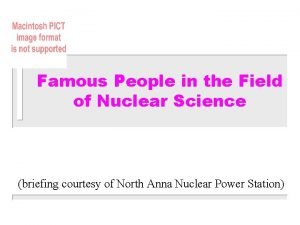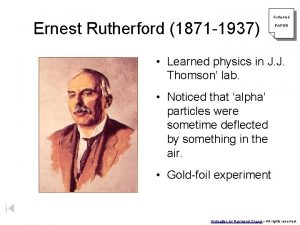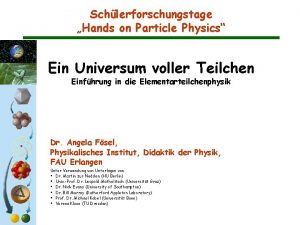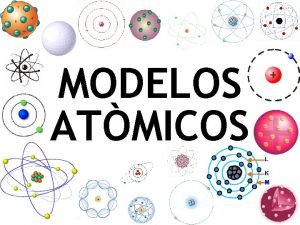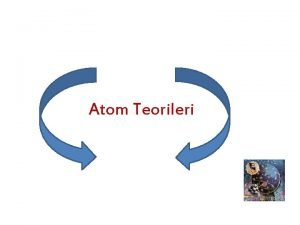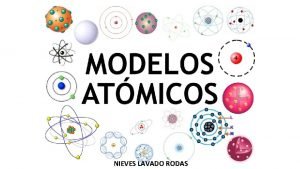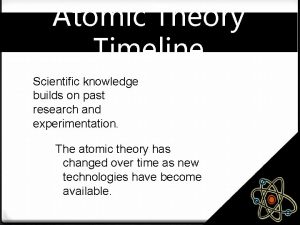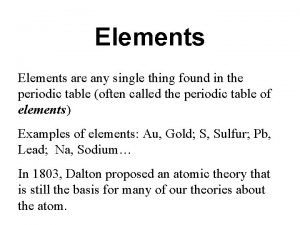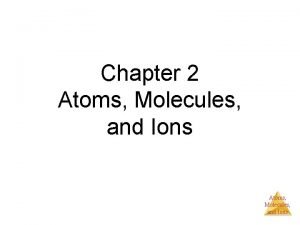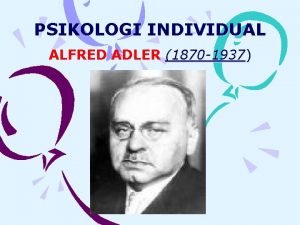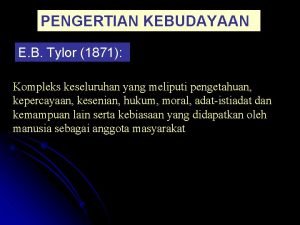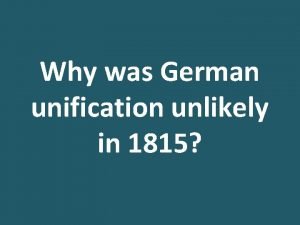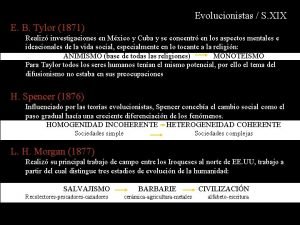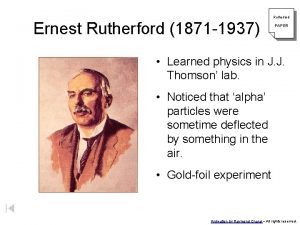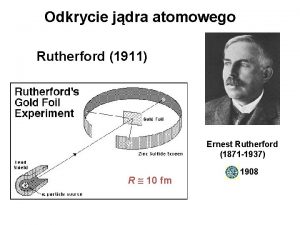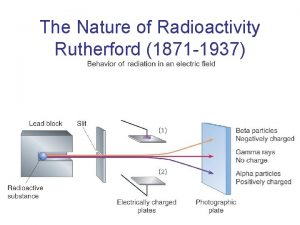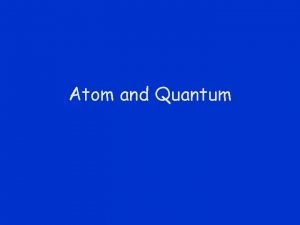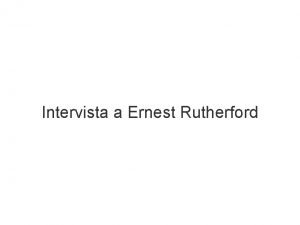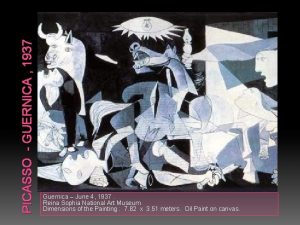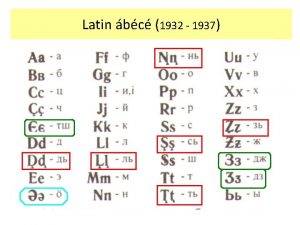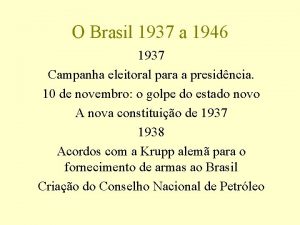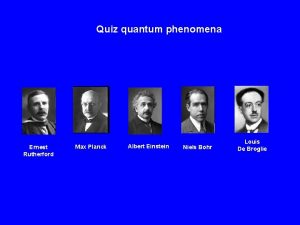Ernest Rutherford 1871 1937 1 Discovered the true










































- Slides: 42


Ernest Rutherford 1871 -1937 1. Discovered the true nature of the radioactive radiation, a, b, and g rays. Invented isotope dating. 2. His a particle scattering experiments (1909) revealed the true nature of the atomic structure. 3. Rutherford became in 1917 the first person to deliberately transmute one element into another, when he converted nitrogen into oxygen through the nuclear reaction 14 N + α → 17 O + proton.


James Chadwick 1891 -1974 英國 Discovery of neutron in 1932 Deep-Penetrating g-ray like radiation

5


7

Why are the atomic nuclei stable? 8


The Zone of Stability Copyright © Cengage Learning. All rights reserved 10

Radioactive Stability • Nuclides (原子核) with 84 or more protons are unstable. • Light nuclides are stable when Z (質子數) equals A (質量數) – Z (neutron/proton ratio is 1). • For heavier elements the neutron/proton ratio required for stability is greater than 1 and increases with Z. Copyright © Cengage Learning. All rights reserved 11

Types of Radioactive Decay • Alpha production : • Beta production : Copyright © Cengage Learning. All rights reserved 12

Types of Radioactive Decay • Gamma ray production : • Positron production: t 1/2 = 110 min. Copyright © Cengage Learning. All rights reserved 13

Types of Radioactive Decay • Electron capture: Inner-orbital electron Copyright © Cengage Learning. All rights reserved 14

Radioactive Dating t 1/2 = 4. 47 billion years t 1/2 = 704 million years t 1/2 = 5730 years 15

Decay Series (Series of Alpha and Beta Decays) Copyright © Cengage Learning. All rights reserved 16

Nuclear Transformation The change of one element into another. Alchemists’ Dream!? Copyright © Cengage Learning. All rights reserved 17

Nuclear Fission and Fusion • Fusion – Combining two light nuclei to form a heavier, more stable nucleus. • Fission – Splitting a heavy nucleus into two nuclei with smaller mass numbers. 18

Proton Chain Fusion Energy Released = 25 Me. V C + O 2 CO 2, DH = 10 e. V

Small mass deficit in nuclear reactions translates to large energy release ! 20

Nuclear Binding Energies stronger binding, more mass deficit more energy released 21

Chain Reactions in Nuclear Fission Critical Mass = 52 kg, 17 cm in diameter >= critical mass, self-sustained fission 22

The “Little Boy” Mass = 64 kg of 235 U Only 0. 6 g of mass was converted to energy by E = m c 2 The mushroom cloud of the atomic bombing (fat man) of Nagasaki (長崎), Japan on August 9, 1945 rose some 18 kilometers (11 miles) above the bomb's hypocenter. ~15 kiloton of TNT 23

Schematic Diagram of a Nuclear Power Plant Copyright © Cengage Learning. All rights reserved 24

Schematic Diagram of a Reactor Core Copyright © Cengage Learning. All rights reserved 25

26

What particles are really elementary (indivisible)? 27

Inner Structure of Nucleons Proton (+) Neutron (0) up and down quarks were discovered in 1968 at the Stanford Linear Accelerator Center. Other quarks were discovered in subsequent years: strang (1968), charm (1974), bottom (1977), top (1995) 28

Particles of Matter and Messenger proton mass = 938 Me. V up quark = 2. 4 Me. V down quark = 4. 8 Me. V Why is proton so heavy?

The Standard Model 30

Close-Up View of a Helium Atom 31

32

Particle and Forces in Standard Model String Theory in 11 -D? 33

Summary of current knowledge on particles and forces All elementary particles are either bosons or fermions (depending on their spin). According to this methodology: Particles normally associated with matter are fermions. They have half-integer spin and are divided into twelve flavours. Particles associated with fundamental forces are bosons and they have integer spin. Fermions: Quarks — up, down, charm, strange, top, bottom Leptons — electron neutrino, electron, muon neutrino, muon, tau neutrino, tau Bosons: Gauge bosons — gluon, W and Z bosons, photon Other bosons — Higgs boson, graviton 34

Gravitational force, the weakest of the four forces, is about 10 -36 times the strength of the strong nuclear force. The messenger particle of gravitational force is the graviton. It has not been experimentally verified, mainly because it is extremely hard to find the smallest denomination of the weakest force. Recent calculations show that it will likely be massless. Gravitational force is always attractive and that's what hold our universe together. 35

Electromagnetism (EM) Its strength is a bit less than strong nuclear force, and unlike gravitational force, it has both attractive and repulsive nature and is of infinite range-like gravity. The EM is responsible for keeping up electrons around nucleus(attraction force between nucleus and electrons). It is the force that causes the interaction between electrically charged particles; the areas in which this happens are called EM fields. The particle that carry electromagnetism is the photon, a massless particle that travels at a speed of 299 792 458 m/s or 299 972 km/s. 36

The Weak Nuclear Force The weak nuclear force is one of the less familiar fundamental forces. It operates only on the extremely short distance scales found in an atomic nucleus. The weak force is responsible for radioactive decay. In actuality, it is stronger than electromagnetism, but its messenger particles (W and Z bosons) are so massive and sluggish that they do not faithfully transmit its intrinsic strength. 37

The Strong Nuclear Force Like the weak force, its range is limited to subatomic distances. Guarks which forms the protons and neutrons stick together through this force. This force is carried by gluons and is a massless particle, as it glues the quarks together. Gluons also acts on other gluons and that is why, as the distance increases the force increases at subatomic level. Theory of Everything (TOE)? Attempts have been going on to unify all these four fundamental forces to form a grand unified theory, and had successfully unified the other three, excluding gravity. Hope they will succeed soon. 38

Large Hardon Collider (LHC), Geneva 27 km, $ 4. 4 billion France–Switzerland border 39

Compact Muon Solenoid (CMS) Detector at LHC proton-antiproton collider at 14 Te. V, v = 0. 999 991 c 40

41

Physicists Find Elusive Particle (Higgs Boson) Seen as Key to Universe July 4, 2012 in Geneva Mass = 126 Ge. V 2013 Nobel Prize in Physics (François Englert and Peter W. Higgs ) 42
 1937-1871
1937-1871 Rutherford gold foil
Rutherford gold foil Ernest rutherford steckbrief
Ernest rutherford steckbrief Ernest rutherford objevy
Ernest rutherford objevy Modelos atomicos de schrodinger
Modelos atomicos de schrodinger Ernest rutherford atom modeli
Ernest rutherford atom modeli Modelo atomico de rutherford
Modelo atomico de rutherford Ernest rutherford objevy
Ernest rutherford objevy Niels bohr atomic theory timeline
Niels bohr atomic theory timeline Plum pudding model
Plum pudding model Modelos atomicos mapa conceptual
Modelos atomicos mapa conceptual Rutherford streuversuch durchführung
Rutherford streuversuch durchführung What did ernest rutherford discover
What did ernest rutherford discover July 2 1937 amelia earhart
July 2 1937 amelia earhart Us composer glass
Us composer glass Why is the 1936-1937 period known as the “crack-up”?
Why is the 1936-1937 period known as the “crack-up”? 1937 computer
1937 computer Pablo picasso modernismen
Pablo picasso modernismen 1937 computer
1937 computer Salvador dali nacio
Salvador dali nacio Gerindo berdiri di jakarta 24 mei 1937 akibat dari
Gerindo berdiri di jakarta 24 mei 1937 akibat dari Fictional finalism bersifat
Fictional finalism bersifat Creator of the first computer
Creator of the first computer Continental 1871
Continental 1871 Tylor culture definition
Tylor culture definition Verfassung 1871
Verfassung 1871 Germany before 1871
Germany before 1871 Edward burnett tylor evolucionismo
Edward burnett tylor evolucionismo 102 dr
102 dr Chapter 2 jesus christ true god and true man
Chapter 2 jesus christ true god and true man đại từ thay thế
đại từ thay thế Diễn thế sinh thái là
Diễn thế sinh thái là Vẽ hình chiếu vuông góc của vật thể sau
Vẽ hình chiếu vuông góc của vật thể sau Công thức tiính động năng
Công thức tiính động năng Thế nào là mạng điện lắp đặt kiểu nổi
Thế nào là mạng điện lắp đặt kiểu nổi Tỉ lệ cơ thể trẻ em
Tỉ lệ cơ thể trẻ em Lời thề hippocrates
Lời thề hippocrates Vẽ hình chiếu đứng bằng cạnh của vật thể
Vẽ hình chiếu đứng bằng cạnh của vật thể độ dài liên kết
độ dài liên kết Quá trình desamine hóa có thể tạo ra
Quá trình desamine hóa có thể tạo ra Các môn thể thao bắt đầu bằng từ đua
Các môn thể thao bắt đầu bằng từ đua Hát kết hợp bộ gõ cơ thể
Hát kết hợp bộ gõ cơ thể Khi nào hổ con có thể sống độc lập
Khi nào hổ con có thể sống độc lập
